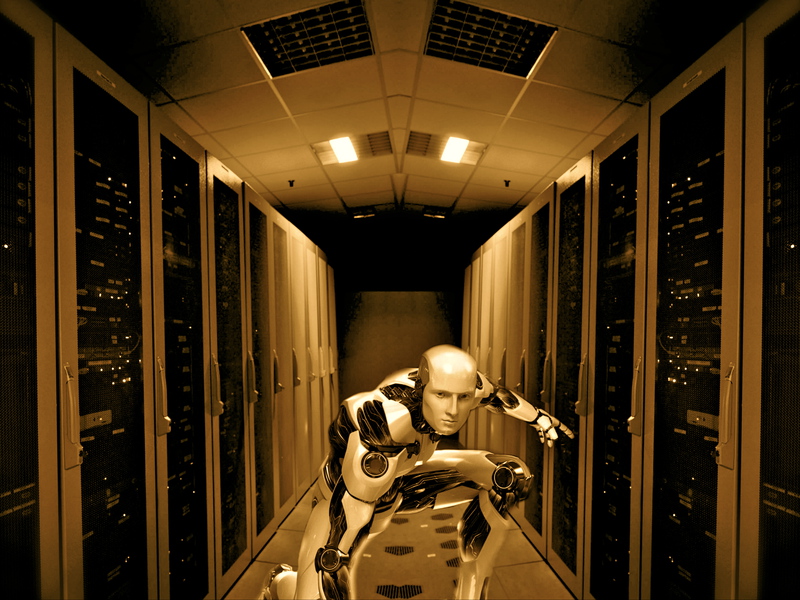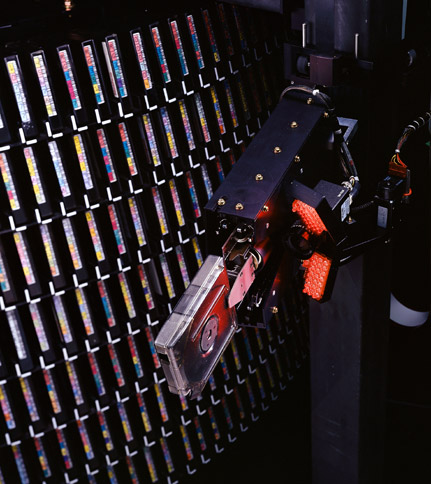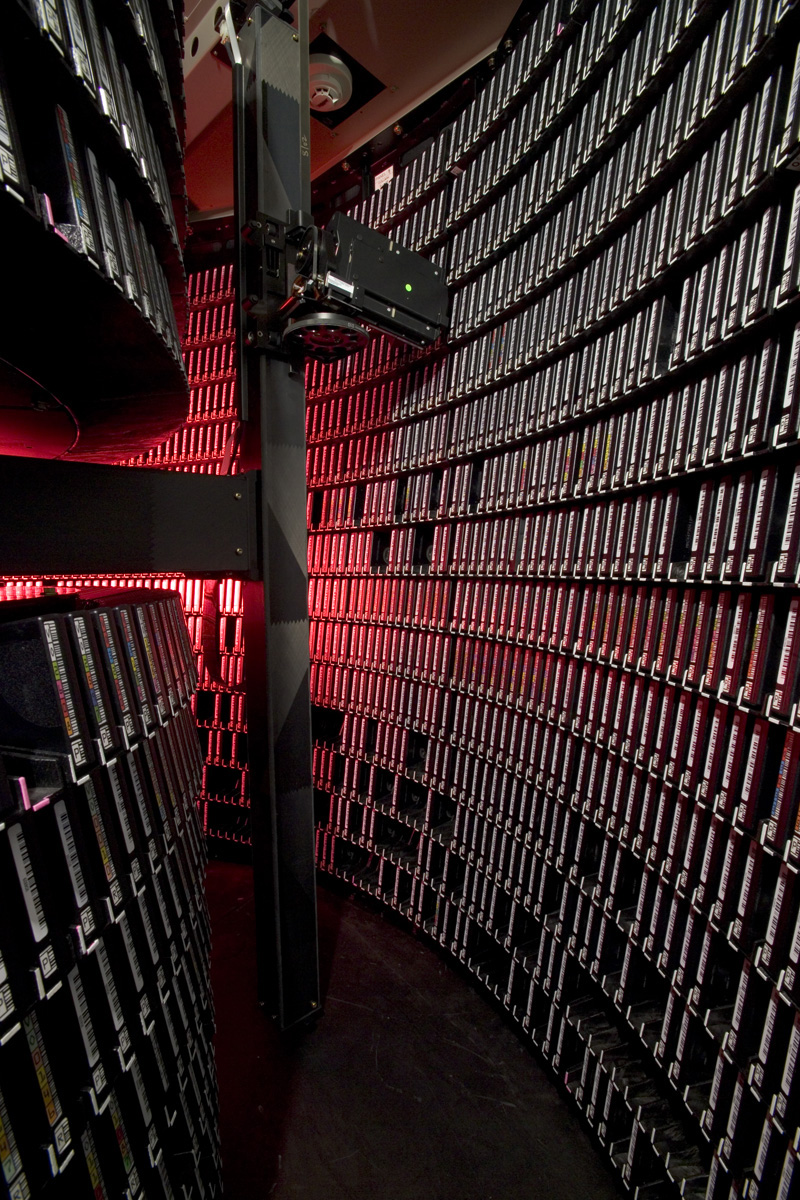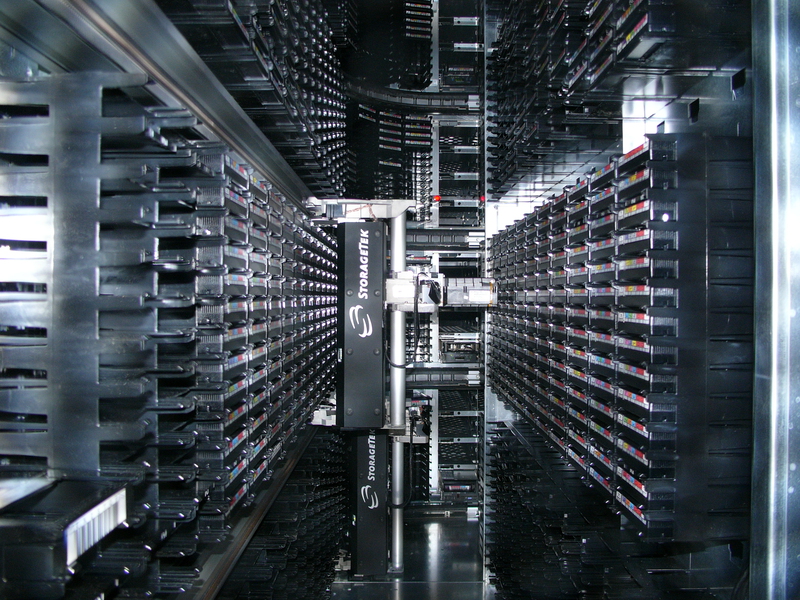Robotic Data Center of the Future
In modern data processing centers (DPC-s) a kind of evolution is taking place. Data processing giants such as Google and Amazon are quietly redefining the future of data centers. This process involves the use of robotics to create a fully automated "dark" ("Lights-Out") data center.

Let's draw some parallels. There are quite a few similarities between the modern warehouse and the modern high-tech Data Center. Both here and there an organized structure, a high level of automation is present, and the building plan is designed in such a way as to use the free space as efficiently as possible. Such large organizations like Amazon have long used the most advanced control technologies, including robotics, to automate and control their warehouses.
')
Google's Virtual Tape Libraries (Connie Zhou photo for Google) are an example of using robotics to manage data centers. Manipulators, which we see at the end of the aisle, can load and unload tapes.

And the question is - is there a logical sense of the global introduction of such technologies in the data center?
Robotics in the data center
According to technologists, the dependence on data centers continues to grow rapidly, and therefore, robotic automation of software and hardware is no longer a matter of need for implementation, but a matter of the timing of implementation. Robotic organizations, such as Chicago-based DevLinks LTD, have already begun discussions and creating plans for designing a fully automated data center.
Scott Jackson, a senior programmer at Robotics DevLinks, claims that it will soon be quite possible to send a robot to bring a disk, a server, or even a chassis and install them into a central unit.

“Simple RFID-based (radio frequency identification), laser and barcode identifiers are really capable of creating true automation in the Data Center,” explains S. Jackson. "For example, you can mark disks with RFID tags and assign their removal, destruction or reuse depending on your needs." The conveyor system and robotics can operate in parallel within the data center.
There are already working examples of robotization of Data Centers. Google's virtual tape libraries and high-performance computing data centers use robotic manipulators to find and collect backups on storage tapes.
Video showing this process:
What will change?
What can a fully robotic “dark” Data Center look like? It will be raked robots that can move around the entire data center. Another interesting nuance is the fact that a modern data center will not be limited to horizontal expansion of space. When using robotics, the data center can literally grow upwards. Efficient use of data center space has always been a problem for providers, so the possibility of expanding both horizontally and vertically can rightly be considered a great advantage.
“Due to such robots, the entire rack, which can now be much higher, will be increased, given the possibility of these intelligent robots to reach any height,” says S. Jackson. “As soon as some part is removed, the conveyor can move it to the corresponding zone. In addition, detailed scanning technologies have also greatly evolved. Solutions like Cognex allow machines to identify parts, bar codes, and many other variables to determine the destination (shipment) of the part or its origin. ”

Large organizations that invest large amounts of money in their Data Centers are actively exploring such robotic solutions to improve control over their data centers. IT companies such as Amazon and Google are already looking for ways to create a fully automated "dark" Data Center. AOL is taking the first steps in this direction with its "unmanned" data center.
Cost of solution
As with any technology, the cost of robotics for Data Centers will initially be high, but over time it will fall, due to the evolution of such a platform. Smaller robots are already becoming cheaper. Such manufacturers as FANUC create not only large machines, but also smaller, more mobile robots. Models like the LR and Mate M-1iA pave the way for super-mobile and fast robots capable of identifying and distributing parts.
Both Data Centers, automation technologies, and robotic technologies have come a long way in the last few decades. From the point of view of warehousing, robots already know where and what lies, how to put things in order, and also know how to directly interact with human-created automation programs. At the expense of robotics, something interesting happens: instead of the person going to the warehouse, the warehouse goes to the person.
Soon this will be possible at the level of Data-Center.
This would create a completely new approach to management. Your Data Center will be able to function at a different temperature level, the need for lighting will disappear, and you will be able to directly integrate your new robotic platform into a modern automation and organization system. Through the main command center, the operator (person) will be able to monitor the state of the Data Center, the robotic infrastructure and the controlled workload. All this can be done without the need for anyone in the data center itself.
Challenges, problems and benefits
Will Data-Centers administrators replace such technology? Not. However, it can cause a gradual evolution in the world of Data Centers and create a new model of training future system engineers. Human control is and will be necessary. No matter how smart and advanced these machines become, a person will still have to enter commands and perform basic maintenance. Data center administrators should think about how to always be aware of events and integrate their systems into incoming robotic platforms.

Nevertheless, the creation of such a platform will not be very easy. First, there is still no plan or scheme for such platforms designed ... today. Plus, there are many problems with the implementation of ideas that require analysis. Here are examples of the very problems and advantages of this technology.
Problems
• Server hardware has not yet been designed to be transported by machines. Much attention is now paid to expensive server hardware and hardware components. In this regard, the adaptation of the two systems, either from the server side or from the robotics manufacturers, must be introduced.
• The need to create unique hardware. To cope with robotics, servers, racks and the entire data center, in general, must be changed. Not only new types of space should be built from the very beginning, but the project should also take into account major changes in bandwidth and workflow of the Data Center itself.
• The cable system must be specialized. Creating a simple physical switch or gate valve will allow the machine to insert or remove a server very easily. But what about the back panel, or the switch, for example? A very neat system of laying cables and wires during the operation of robotics must be created.
• High investment costs for automation. Creating a data center managed by robots will not be cheap. In addition to the cost of physical hardware related to the server components (which must be specified), the cost of locating robotics and creating a specific structure for them emerges. As with warehouses, a systematic workflow must exist in the data center. Robotics throws a "twisted ball" throughout the process, since it must logically perform the programmed actions.
• The return on investment should be clear. Before considering any such project, a thorough cost analysis should be made. For small companies, the use of robotics and automation will not make sense for some time. However, for companies like Amazon and Google, the return on investment will occur much earlier.
Benefits
• Increase the data center not only in the horizontal plane, but also in the vertical. Robots allow you to effectively use the space of the entire data center. Robots allow us to get higher and advance further than was previously possible. The ability to grow up allows the data center to create new concepts of efficient use of space.
• Significant (almost complete) elimination of the need for lighting. Not only lighting, but many other costly items can be eliminated. The small amenities needed by a person and occupying space will no longer be included in the data center structure.
• A huge reduction in downtime (down-time). Knowing that all operational processes of the structure are fully structured and functional, almost all aspects of managing the Data Center can be organized and calculated. Currently, if the server fails, the administrator can replace the hardware part within a few minutes. With a robot, every smallest detail and function will be calculated and predictable. There will be no more guessing - everything can be predicted and controlled.
• Machines are able to operate at slightly higher temperatures, like new server models. The new generation of server technologies is being developed with the ability to withstand higher temperatures, both during operation and off. This also applies to robotics. In a fully integrated “dark” Data Center, aspects of the environment can be completely shifted towards efficiency and hardware control.
• Long-term return on investment. While development and implementation may require long-running advances, the long-term benefit is obvious. Administrators will be able to directly align the software and hardware of automated platforms with their robotic infrastructure. Everything will work in unison, creating a truly efficient data center mechanism. Considering much less downtime, higher workload and simplified management, significant cost savings can be realized within a properly-designed data center infrastructure.
Now there are already achievements in the field of workflow automation, “clouds” and hardware. The next step is the integration of robotics into this structure and the creation of a data center of the future. And so, when will this type of system become a reality?
“I cannot determine exact dates,” says S. Jackson. “But I know that some large data centers are already discussing and testing such technologies. It may take about two years to plan, design and implement something like this. I wouldn’t be surprised, however, if this really starts in the next five years or so. ”
Source: datacenterknowledge.com
Bill kleyman

“Lights-Out” data center is a data center, also known as “darkened” or “dark”, which does not need direct human intervention in its work. Since there should be no people in such a data center, the use of lighting is not required, from which a peculiar name originated.
Let's draw some parallels. There are quite a few similarities between the modern warehouse and the modern high-tech Data Center. Both here and there an organized structure, a high level of automation is present, and the building plan is designed in such a way as to use the free space as efficiently as possible. Such large organizations like Amazon have long used the most advanced control technologies, including robotics, to automate and control their warehouses.
')
Google's Virtual Tape Libraries (Connie Zhou photo for Google) are an example of using robotics to manage data centers. Manipulators, which we see at the end of the aisle, can load and unload tapes.

And the question is - is there a logical sense of the global introduction of such technologies in the data center?
Robotics in the data center
According to technologists, the dependence on data centers continues to grow rapidly, and therefore, robotic automation of software and hardware is no longer a matter of need for implementation, but a matter of the timing of implementation. Robotic organizations, such as Chicago-based DevLinks LTD, have already begun discussions and creating plans for designing a fully automated data center.
Scott Jackson, a senior programmer at Robotics DevLinks, claims that it will soon be quite possible to send a robot to bring a disk, a server, or even a chassis and install them into a central unit.

“Simple RFID-based (radio frequency identification), laser and barcode identifiers are really capable of creating true automation in the Data Center,” explains S. Jackson. "For example, you can mark disks with RFID tags and assign their removal, destruction or reuse depending on your needs." The conveyor system and robotics can operate in parallel within the data center.
There are already working examples of robotization of Data Centers. Google's virtual tape libraries and high-performance computing data centers use robotic manipulators to find and collect backups on storage tapes.
Video showing this process:
What will change?
What can a fully robotic “dark” Data Center look like? It will be raked robots that can move around the entire data center. Another interesting nuance is the fact that a modern data center will not be limited to horizontal expansion of space. When using robotics, the data center can literally grow upwards. Efficient use of data center space has always been a problem for providers, so the possibility of expanding both horizontally and vertically can rightly be considered a great advantage.
“Due to such robots, the entire rack, which can now be much higher, will be increased, given the possibility of these intelligent robots to reach any height,” says S. Jackson. “As soon as some part is removed, the conveyor can move it to the corresponding zone. In addition, detailed scanning technologies have also greatly evolved. Solutions like Cognex allow machines to identify parts, bar codes, and many other variables to determine the destination (shipment) of the part or its origin. ”

Large organizations that invest large amounts of money in their Data Centers are actively exploring such robotic solutions to improve control over their data centers. IT companies such as Amazon and Google are already looking for ways to create a fully automated "dark" Data Center. AOL is taking the first steps in this direction with its "unmanned" data center.
Cost of solution
As with any technology, the cost of robotics for Data Centers will initially be high, but over time it will fall, due to the evolution of such a platform. Smaller robots are already becoming cheaper. Such manufacturers as FANUC create not only large machines, but also smaller, more mobile robots. Models like the LR and Mate M-1iA pave the way for super-mobile and fast robots capable of identifying and distributing parts.
Both Data Centers, automation technologies, and robotic technologies have come a long way in the last few decades. From the point of view of warehousing, robots already know where and what lies, how to put things in order, and also know how to directly interact with human-created automation programs. At the expense of robotics, something interesting happens: instead of the person going to the warehouse, the warehouse goes to the person.
Soon this will be possible at the level of Data-Center.
This would create a completely new approach to management. Your Data Center will be able to function at a different temperature level, the need for lighting will disappear, and you will be able to directly integrate your new robotic platform into a modern automation and organization system. Through the main command center, the operator (person) will be able to monitor the state of the Data Center, the robotic infrastructure and the controlled workload. All this can be done without the need for anyone in the data center itself.
Challenges, problems and benefits
Will Data-Centers administrators replace such technology? Not. However, it can cause a gradual evolution in the world of Data Centers and create a new model of training future system engineers. Human control is and will be necessary. No matter how smart and advanced these machines become, a person will still have to enter commands and perform basic maintenance. Data center administrators should think about how to always be aware of events and integrate their systems into incoming robotic platforms.

Nevertheless, the creation of such a platform will not be very easy. First, there is still no plan or scheme for such platforms designed ... today. Plus, there are many problems with the implementation of ideas that require analysis. Here are examples of the very problems and advantages of this technology.
Problems
• Server hardware has not yet been designed to be transported by machines. Much attention is now paid to expensive server hardware and hardware components. In this regard, the adaptation of the two systems, either from the server side or from the robotics manufacturers, must be introduced.
• The need to create unique hardware. To cope with robotics, servers, racks and the entire data center, in general, must be changed. Not only new types of space should be built from the very beginning, but the project should also take into account major changes in bandwidth and workflow of the Data Center itself.
• The cable system must be specialized. Creating a simple physical switch or gate valve will allow the machine to insert or remove a server very easily. But what about the back panel, or the switch, for example? A very neat system of laying cables and wires during the operation of robotics must be created.
• High investment costs for automation. Creating a data center managed by robots will not be cheap. In addition to the cost of physical hardware related to the server components (which must be specified), the cost of locating robotics and creating a specific structure for them emerges. As with warehouses, a systematic workflow must exist in the data center. Robotics throws a "twisted ball" throughout the process, since it must logically perform the programmed actions.
• The return on investment should be clear. Before considering any such project, a thorough cost analysis should be made. For small companies, the use of robotics and automation will not make sense for some time. However, for companies like Amazon and Google, the return on investment will occur much earlier.
Benefits
• Increase the data center not only in the horizontal plane, but also in the vertical. Robots allow you to effectively use the space of the entire data center. Robots allow us to get higher and advance further than was previously possible. The ability to grow up allows the data center to create new concepts of efficient use of space.
• Significant (almost complete) elimination of the need for lighting. Not only lighting, but many other costly items can be eliminated. The small amenities needed by a person and occupying space will no longer be included in the data center structure.
• A huge reduction in downtime (down-time). Knowing that all operational processes of the structure are fully structured and functional, almost all aspects of managing the Data Center can be organized and calculated. Currently, if the server fails, the administrator can replace the hardware part within a few minutes. With a robot, every smallest detail and function will be calculated and predictable. There will be no more guessing - everything can be predicted and controlled.
• Machines are able to operate at slightly higher temperatures, like new server models. The new generation of server technologies is being developed with the ability to withstand higher temperatures, both during operation and off. This also applies to robotics. In a fully integrated “dark” Data Center, aspects of the environment can be completely shifted towards efficiency and hardware control.
• Long-term return on investment. While development and implementation may require long-running advances, the long-term benefit is obvious. Administrators will be able to directly align the software and hardware of automated platforms with their robotic infrastructure. Everything will work in unison, creating a truly efficient data center mechanism. Considering much less downtime, higher workload and simplified management, significant cost savings can be realized within a properly-designed data center infrastructure.
Now there are already achievements in the field of workflow automation, “clouds” and hardware. The next step is the integration of robotics into this structure and the creation of a data center of the future. And so, when will this type of system become a reality?
“I cannot determine exact dates,” says S. Jackson. “But I know that some large data centers are already discussing and testing such technologies. It may take about two years to plan, design and implement something like this. I wouldn’t be surprised, however, if this really starts in the next five years or so. ”
Source: datacenterknowledge.com
Bill kleyman
Source: https://habr.com/ru/post/181165/
All Articles